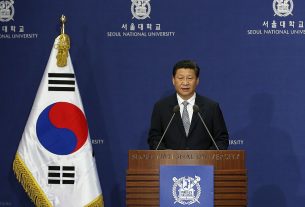TRT: 04:11
SOURCE: IMF
RESTRICTIONS: NONE
LANGUAGE: ENGLISH / NATS
DATELINE: 30 JANUARY 2023, WASHINGTON DC / FILE
SHOTLIST:
RECENT – WASHINGTON DC
1. Wide shot, IMF building exterior
2. Wide shot, IMF logo on building
30 JANUARY 2023, WASHINGTON DC
3. SOUNDBITE (English) Pierre-Olivier Gourinchas, Chief Economist, International Monetary Fund (IMF):
“The global economy will slow down this year before rebounding in 2024. But a global recession is not in our baseline. The important factors shaping the outlook are: On the downside, Russia’s war in Ukraine and the global fight against inflation. On the upside, the reopening of China’s economy. Overall, we have a mild upward revision to our projections. The global economy has shown a lot of resilience. Labor markets are tight, household spending and business investment remain strong, and European economies proved quite resilient against the energy crisis. Global growth is expected to slow from 3.4 percent in 2022 to 2.9 percent in 2023. The slowdown will be more pronounced for advanced economies. China and India will account for 50% of global growth. Global headline inflation is expected to fall from 8.8 percent in 2022 to 4.3 percent in 2024. Core inflation, however, is more persistent and remains too elevated. To sum up, barring new shocks, 2023 could be the year of turning points, with growth bottoming out and inflation decreasing.”
4. Wide shot, Pierre-Olivier Gourinchas talking
5. SOUNDBITE (English) Pierre-Olivier Gourinchas, Chief Economist, International Monetary Fund (IMF):
“The balance of risks to the outlook remains tilted to the downside but is less skewed toward adverse outcomes than in the October WEO. Some upside risks have become more relevant. On the downside, China’s recovery could stall with spillovers to the rest of the world. Inflation could persist at high levels, requiring even tighter monetary policy. An escalation of the war in Ukraine remains a major risk to the global economy, and a sudden repricing in financial markets could deteriorate financial conditions, especially for emerging and developing economies. On the upside, strong household balance sheets amid tight labor markets and robust wage growth could help sustain private demand. Easing of remaining supply bottlenecks, coupled with easing labor market pressures, could also allow for a soft landing with less monetary tightening,”
6. Wide shot, Pierre-Olivier Gourinchas talking
7. SOUNDBITE (English) Pierre-Olivier Gourinchas, Chief Economist, International Monetary Fund (IMF):
“The fight against inflation has started to bear fruit, but the battle is far from won. Central banks need to raise real policy rates above the neutral level and keep them there until inflation is on a sustained declining path. Central banks and prudential authorities must closely monitor the buildup of risks and vulnerabilities, especially in the housing and non-bank financial sectors. Countries should also roll back the broad and untargeted support they provided households and firms to counter the cost-of-living crisis and instead adopt targeted measures to conserve fiscal space, allow the energy price signal to reduce energy demand and avoid overly stimulating the economy. More progress is also needed on orderly debt restructuring through the Group of 20’s Common Framework. Non-Paris Club and private creditors have a crucial role to play. Supply side policies should be used to reduce growth bottlenecks, improve resilience, alleviate price pressures, and accelerate the green transition. Finally, urgent action is needed to halt the forces of geoeconomics fragmentation and strengthen multilateral cooperation in areas of common interest; international trade, the global financial safety net, public health preparedness, and the climate transition,”
RECENT – WASHINGTON DC
STORYLINE:
The IMF announced today (30 Jan) that global growth is expected to slow from 3.4 percent in 2022 to 2.9 percent in 2023 in a press briefing held in Singapore to mark the launch of the January update of the World Economic Outlook report.
The global economy is poised to slow this year, before rebounding next year.
“The global economy will slow down this year before rebounding in 2024. But a global recession is not in our baseline. The important factors shaping the outlook are: On the downside, Russia’s war in Ukraine and the global fight against inflation. On the upside, the reopening of China’s economy. Overall, we have a mild upward revision to our projections. The global economy has shown a lot of resilience. Labor markets are tight, household spending and business investment remain strong, and European economies proved quite resilient against the energy crisis. Global growth is expected to slow from 3.4 percent in 2022 to 2.9 percent in 2023. The slowdown will be more pronounced for advanced economies. China and India will account for 50% of global growth. Global headline inflation is expected to fall from 8.8 percent in 2022 to 4.3 percent in 2024. Core inflation, however, is more persistent and remains too elevated. To sum up, barring new shocks, 2023 could be the year of turning points, with growth bottoming out and inflation decreasing,” said Pierre-Olivier Gourinchas, IMF’s Chief Economist.
However, the risks to the outlook remain tilted to the downside, even if adverse risks have moderated since October and some positive factors seem more relevant.
“The balance of risks to the outlook remains tilted to the downside but is less skewed toward adverse outcomes than in the October WEO. Some upside risks have become more relevant. On the downside, China’s recovery could stall with spillovers to the rest of the world. Inflation could persist at high levels, requiring even tighter monetary policy. An escalation of the war in Ukraine remains a major risk to the global economy, and a sudden repricing in financial markets could deteriorate financial conditions, especially for emerging and developing economies. On the upside, strong household balance sheets amid tight labor markets and robust wage growth could help sustain private demand. Easing of remaining supply bottlenecks, coupled with easing labor market pressures, could also allow for a soft landing with less monetary tightening,” added Gourinchas.
Gourinchas stressed that the global economic outlook hasn’t worsened but the road back to a full recovery, with sustainable growth, stable prices, and progress for all, is only starting.
“The fight against inflation has started to bear fruit, but the battle is far from won. Central banks need to raise real policy rates above the neutral level and keep them there until inflation is on a sustained declining path. Central banks and prudential authorities must closely monitor the buildup of risks and vulnerabilities, especially in the housing and non-bank financial sectors. Countries should also roll back the broad and untargeted support they provided households and firms to counter the cost-of-living crisis and instead adopt targeted measures to conserve fiscal space, allow the energy price signal to reduce energy demand and avoid overly stimulating the economy. More progress is also needed on orderly debt restructuring through the Group of 20’s Common Framework. Non-Paris Club and private creditors have a crucial role to play. Supply side policies should be used to reduce growth bottlenecks, improve resilience, alleviate price pressures, and accelerate the green transition. Finally, urgent action is needed to halt the forces of geoeconomics fragmentation and strengthen multilateral cooperation in areas of common interest; international trade, the global financial safety net, public health preparedness, and the climate transition,” said Gourinchas.



